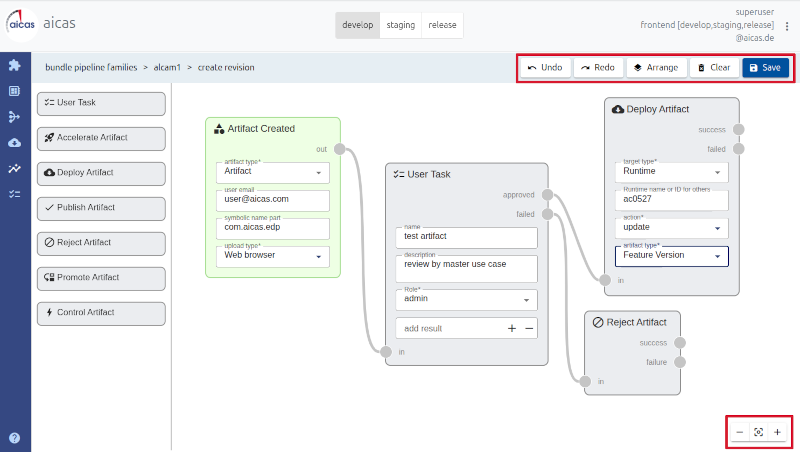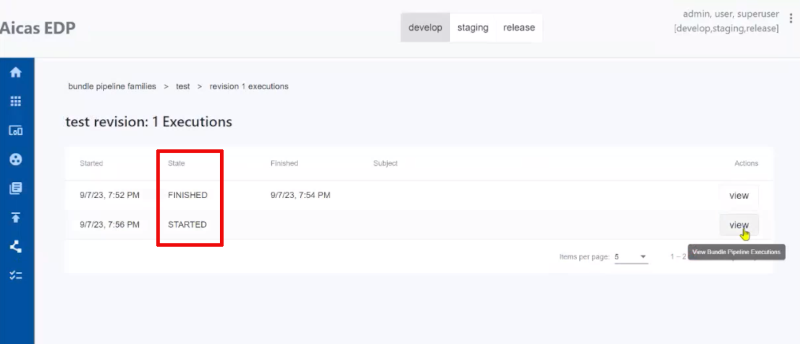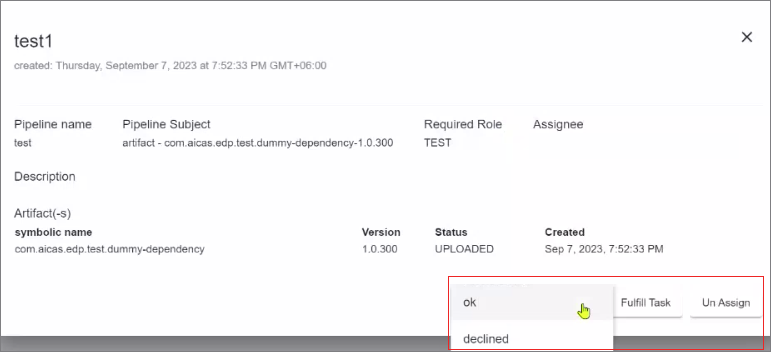Managing the Pipeline¶
EDP implements a dynamic bundle pipeline through two menu options: Bundle Pipelines and User Tasks.
The Bundle Pipeline¶
Once the menu option Bundle Pipelines (BP) is chosen, users will see a list of BP families. Existing families can have their metadata edited and, in case a family is empty (no revisions), it can be deleted. Revisions are instances of the BP family and cover the different updates made during the work of developing a feature. A BP family is conceived as a group of BP revisions (versions) that execute the same goal.
The first step for users to define a pipeline would be to create a new BP family, starting by entering its name and a brief description.
After having been saved, the new BP family appears on the list. Select it and click on Create
Revision to define the pipeline in the canvas area. Functionalities to undo, redo, rearrange,
center and zoom can be helpful in this design phase.

Start (green) and action nodes (gray) form a BP. Open in new tab to see full-size image.¶
After defining how the pipeline should look like, by saving it users are asked to provide some
comments about the revision, after which step they may press Save again. The
newly created revision will be added to the revisions’ list of the BP family.
Updating the Pipeline¶
Now let us assume that, with time, the pipeline defined for this revision would prove unfit for the job, and users would like to add some tasks to it. Maybe they want to, after QA approval, apply acceleration before transitioning a bundle to be deployed to a device. Also, in case acceleration fails, it might be useful to introduce another user task to check failures and notify developers.
In this case, just go to the initial BP family page, that
lists the revisions, click on the button labeled Update Revision and
choose unlock. Then work further on the design.
After finishing, click Save and this will create a revision number 2.
Please note
The latest revision will be always the one chosen whenever a BP family is required. However, older revisions still need to be kept in case they are still in use.
BPs are potentially long running processes, that may execute from few minutes up to several days or even weeks. So whenever the developer wishes to update a BP, there might be already some processes running, and a running pipeline may not be changed. Therefore BP families were designed, that keep the different versions available while waiting for a BP to be updated.
Revisions and Executions¶
Once in the BP family page, one can opt for the elimination of a revision. Let us say, after having saved an updated revision 2, a user wants to delete the previous revision 1. In order to disable a revision, just click on the eye icon, which will in turn change into a garbage can: the revision becomes disabled and that is indicated by the value “false” in the column Enabled.
It is also possible to disable the latest revision: in this case, no event will be able to start
this pipeline family, and the family itself can be deleted. However, if some revisions of this
family are still running, they will continue to run until execution is finished. While a revision
runs, it should not be deleted. In order to check the state of a BP execution, while on the
revisions’ list of a BP family, click on executions.
At this point, by clicking on view, one is be able to navigate through the execution,
seeing the action nodes and also the metadata of the events in JSON form.
The arrows are used to unfold details of the artifacts.
In a general view, all executions can be sorted, keeping track of the ones that are already
finished or still running. When the execution is marked as “finished”, the delete
button is enabled for the revision.

Keep track of the BP’s execution state. Open in new tab to see full-size image.¶
On Forced Stops
Note that a “Force Delete” option is also offered while the revision is still running. In case of a forced stop, users will be asked to confirm the action by entering “delete” in an input field. This can be convenient, in case an execution hangs due to bugs, or when the server is killed not gracefully and the pipeline does not receive an error status (an error is also taken as a final status), so that the pipeline hangs.
To see an example of how a complex BP might look and start interacting with it, go to the
Bundle Pipeline start page and click on Create Demo Pipeline. Then navigate through
its automatically created revision, viewing and editing its design (after choosing Unlock).
User Tasks¶
The page User Tasks lets users view a list of all current tasks. As it is not bound to any environment, it shows the same content for “develop”, “staging” and “release”, providing the users have roles that allow them to see the content and work on it.
When a task is chosen, a window pops up, with information like name and description. A user must have a correspondent role, for example “tester”, to be able to see the details of a user task. Under Pipeline Subject we can see the entity to which this task is being applied to, that could be an artifact, showing its symbolic name.
Let us imagine a bundle pipeline triggered by the event Artifact Created. To this event a user task is added named test1, with possible results “ok” or “declined”. By an “ok” result, we want to execute further, adding another user task, which we will simply call here “ok pressed”.
If you click on this specific task, it can be owned by you with a click on Assign to me,
so nobody else can work on it. Once that is done, that task can be again unassigned or resolved, by
choosing one of the answers predefined during the user task definition: let us say
you choose “ok” and then click on “Fulfill Task”.

Tasks: assign, choose the answers and fulfill. Open in new tab to see full-size image.¶
When the task is fulfilled, if you navigate to Bundle Pipelines and choose the correspondent
BP family and revision, you will be able to see a finished execution: by clicking on view,
information will be shown, like event name, artifacts that were uploaded and by whom, and
also information about the user tasks involved in the bundle pipeline, including their states and
the selected answers.
